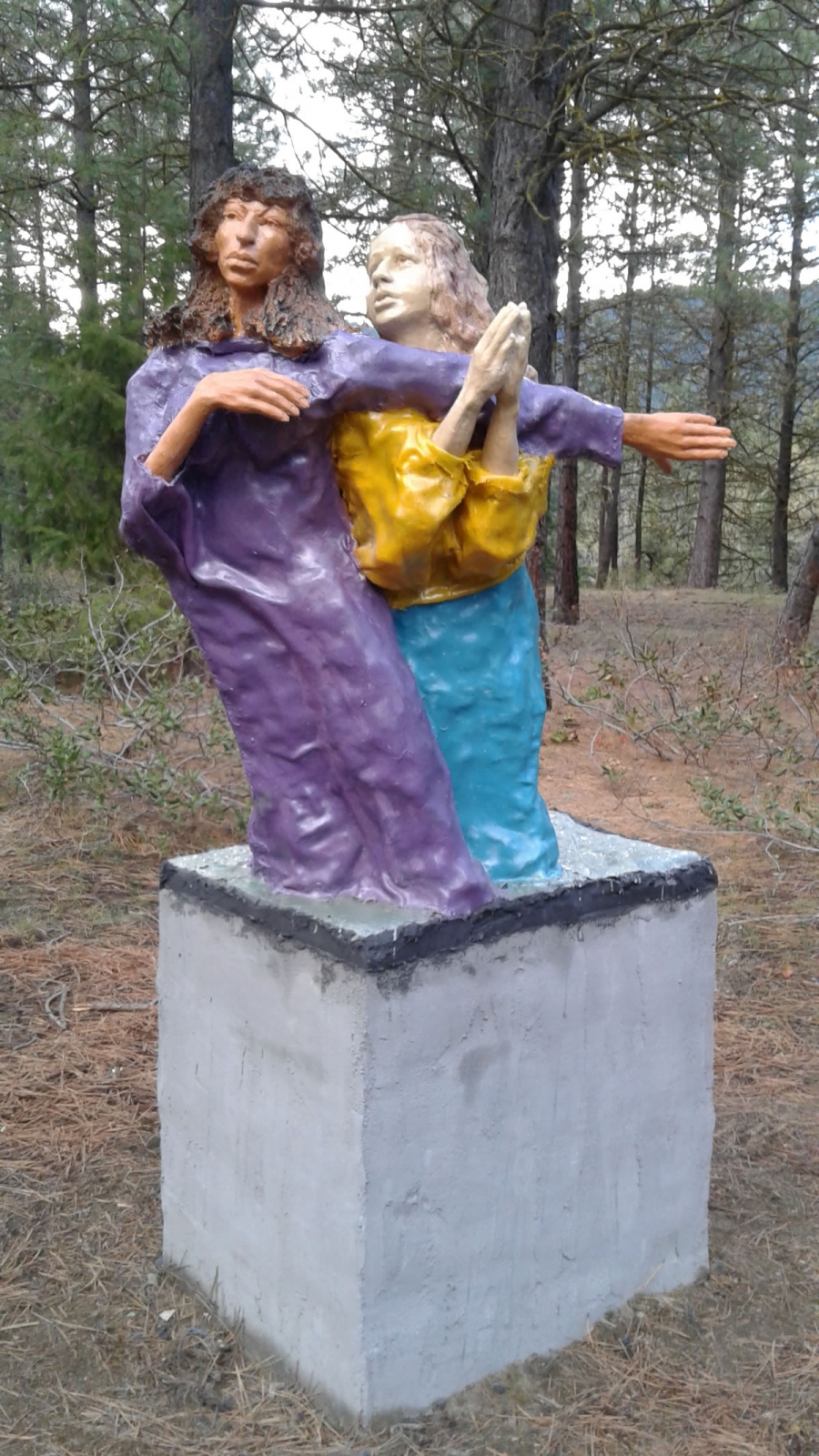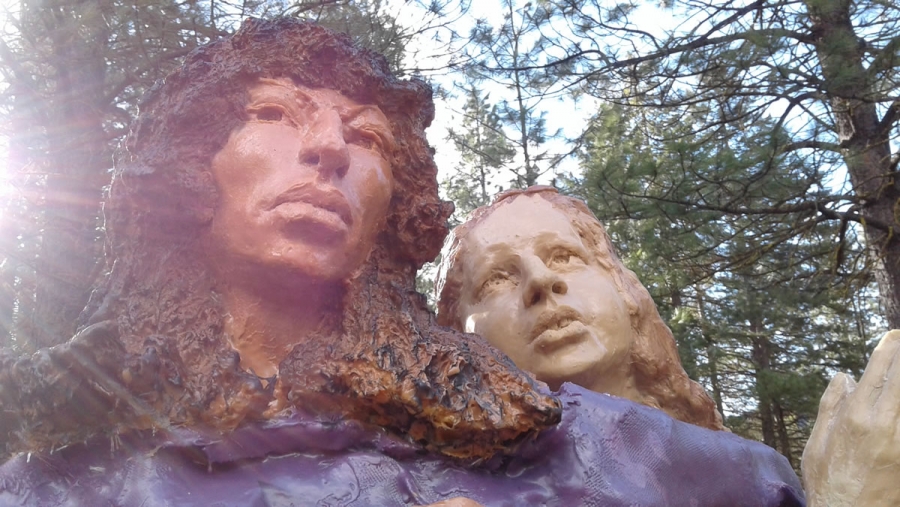The daughters of Lot on the threshold (4985)

Fiberglass, life size, installed in the Grunewald Guild, Plain, Washington
No one can know with certainty what occurred to inspire the story of the destruction of Sodom and Gomorrah. Nor can we really know anything certain about the impact that cataclysm had on the lives of Lot and his family. Nonetheless, theologians, political opinion makers and artists have retold and reanalyzed this story coming to diverse conclusions regarding what “really happened” and what messages the story should convey to us.
In a key moment of this story the righteous (2 Peter 2:6-8) patriarch Lot offered his unmarried daughters to an incensed mob of men in an attempt to placate them (Genesis 19:8):
“I beg you, my brothers, do not act so wickedly. Behold, I have two daughters who have not known any man. Let me bring them out to you, and do to them as you please.”
I was motivated to reinterpret that moment because over the millennia virtually none of the theological or artistic representations of this story have made any sincere effort to understand what might have happened from the point of view of the two unnamed daughters. In this sculpture I attempt to portray these two girls (probably sheltered, adolescent girls rather than women) as threatened individuals betrayed by the most powerful person in their lives. A dramatic, fleeting moment in their lives is reimagined by envisioning them as multidimensional persons with completely human reactions. Here the girls are not mere props in an all male play. This work affirms something that we all know - that female agency has always existed - even when it goes unacknowledged or misrepresented.
The girls react differently. The younger sister is frightened and confused because she had never questioned her father’s love and she cannot comprehend how he could propose that something so reprehensible be done to his baby girl. She could be the fourth daughter of Lot of the Talmudic tradition (Paltith or Plitith), a real sweetie who took pity on a starving homeless man and day after day surrepitiously gave him food and drink only to be punished for her generosity by the unhospitable Sodomites who either burned her alive or hung her in the sun covered in honey so that bees (or ants) would eat her alive. I wonder how much her look - one common in religious iconography as saintly innocence - is in fact disbelief that the world can be so unjust.
On the other hand, the older sister - who I have come to believe is self-possessed, intelligent, fiercely independent and confident - steps forward and stares down the frenzied mob as she extends a protective arm and leg in front of her naïve sister. I envision the older daughter as one of those special, strong humans most of us meet only rarely in our lives. Circumstantial evidence supports this interpretation. She is one of only three women recorded in the Hebrew bible speaking to another woman. Later, in a cave overlooking the smoldering plains of Sodom and Gomorrah and convinced that the entire world had been destroyed, she is said to have taken it upon herself to repopulate the world by arranging that she and her sister would have incestuous relations with their inebriated father. Her decisive actions to save humankind from total extinction gave rise to the lineage that produced Ruth, David and Jesus. Not a bad record for a teenager whose name is not even recorded, Maybe she was such a special person that the scholarly patriarchs had to neutralize her through theological slander.
Just Google “Lot’s Daughters” and you will find dozens of artistic depictions of this story. A few show dutiful daughters accompanying their father out of Sodom with the mother in various states of dehydration. But the majority of artists have chosen to focus on the cave and created explicit salacious and misogynistic depictions of the girls, usually semi nude, as lustful deceivers, procuresses and seductresses. There are very few portrayals that come close to an informed modern interpretation of this story as a classic coverup case in which an alcoholic father is a serial sexual abuser of minors who blames his victims for seducing him. I found only one contemporary artist who (unconvincingly) portrayed the moment of the girls’ vulnerability.
Virtually all biblical commentators blame the teenage girls while giving their mature father a complete pass (the girls are “as shameless as they are nameless” according to one source, and John Calvin savaged them). Today, however, few of us would accept that a powerful and experienced patriarch can be absolved of his shortcomings while blaming his immature and sheltered children. Here the girls can be outside and proudly and safely let their true colors shine – because we humans as a collective have worked for centuries to change our culture. Note that the footprint and the handprint on the girls’ backs are mine. I am neither blameless, nor am I irredemible.
So this sculpture is simultaneously a recognition of the millions of innocent (but I suspect usually not passive) victims of patriarchal systems during millennia and a celebration. We celebrate that modern religious as well as secular thinking decisively condemn formerly acceptable abusive behavior and coverups. But one step further: we need to recognize that antiquated and biased legacies have not completely disappeared and continue to contaminate us today. We should identify and denounce inherited mythologies that are no longer acceptable. Let’s affirm the best characteristics of humanity and our ability to evolve culturally and philosophically.



Find out more in 100 People who deserve monuments


